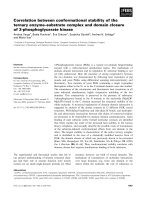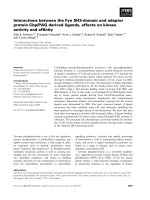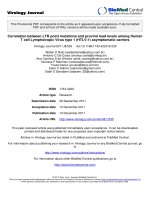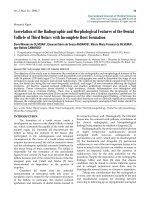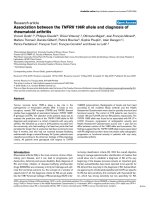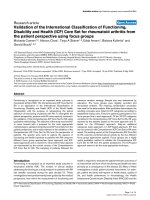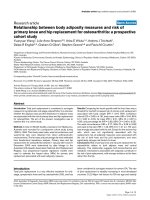Báo cáo y học: "Correlation between the AKI classification and outcome" pdf
Bạn đang xem bản rút gọn của tài liệu. Xem và tải ngay bản đầy đủ của tài liệu tại đây (189.31 KB, 10 trang )
Open Access
Available online />Page 1 of 10
(page number not for citation purposes)
Vol 12 No 6
Research
Correlation between the AKI classification and outcome
Marlies Ostermann
1
, Rene Chang
2
and The Riyadh ICU Program Users Group
1
Departments of Critical Care and Nephrology, Guy's & St Thomas' Foundation Hospital, Westminster Bridge Road, London SE1 7EH, UK
2
Department of Nephrology & Transplantation, St George's University Hospital, Blackshaw Road, London SW17 0QT, UK
Corresponding author: Marlies Ostermann,
Received: 25 Mar 2008 Revisions requested: 29 Apr 2008 Revisions received: 16 Sep 2008 Accepted: 20 Nov 2008 Published: 20 Nov 2008
Critical Care 2008, 12:R144 (doi:10.1186/cc7123)
This article is online at: />© 2008 Ostermann and Chang; licensee BioMed Central Ltd.
This is an open access article distributed under the terms of the Creative Commons Attribution License ( />),
which permits unrestricted use, distribution, and reproduction in any medium, provided the original work is properly cited.
Abstract
Introduction The Acute Kidney Injury Network proposed a new
classification for acute kidney injury (AKI) distinguishing
between three stages. We applied the criteria to a large
intensive care unit (ICU) population and evaluated the impact of
AKI in the context of other risk factors.
Methods Using the Riyadh Intensive Care Program database,
we applied the AKI classification to 22,303 adult patients
admitted to 22 ICUs in the UK and Germany between 1989 and
1999, who stayed in the ICU for 24 hours or longer and did not
have end-stage dialysis dependent renal failure.
Results Of the patients, 7898 (35.4%) fulfilled the criteria for
AKI (19.1% had AKI I 3.8% had AKI II and 12.5% had AKI III).
Mortality in the ICU was 10.7% in patients with no AKI, 20.1%
in AKI I, 25.9% in AKI II and 49.6% in AKI III. Multivariate analysis
confirmed that AKI III, but not AKI I and AKI II, were
independently associated with ICU mortality (odds ratio (OR) =
2.27). Other independent risk factors for ICU mortality were age
(OR = 1.03), sequential organ failure assessment (SOFA) score
on admission to the ICU (OR = 1.11), pre-existing end-stage
chronic health (OR = 1.65), emergency surgery (OR = 2.33),
mechanical ventilation (OR = 2.83), maximum number of failed
organ systems (OR = 2.80) and non-surgical admission (OR =
3.57). Cardiac surgery, AKI I and renal replacement therapy
were associated with a reduced risk of dying in the ICU. AKI II
was not an independent risk factor for ICU mortality. Without
renal replacement therapy as a criterion, 21% of patients
classified as AKI III would have been classified as AKI II or AKI I.
Renal replacement therapy as a criterion for AKI III may
inadvertently diminish the predictive power of the classification.
Conclusions The proposed AKI classification correlated with
ICU outcome but only AKI III was an independent risk factor for
ICU mortality. The use of renal replacement therapy as a
criterion for AKI III may have a confounding effect on the
predictive power of the classification system as a whole.
Introduction
There is increasing agreement that universal criteria for acute
kidney injury (AKI) are needed to facilitate research and
progress in the field of acute renal failure [1-3]. In 2002, the
Acute Dialysis Quality Initiative (ADQI) workgroup convened
an international interdisciplinary group that ultimately pro-
posed the RIFLE classification for AKI, which distinguished
between risk, injury, failure, loss and end-stage kidney disease
[2]. These criteria have now been applied to more than 70,000
patients with varying acute problems and chronic comorbidi-
ties. All studies showed an increase in mortality with worsen-
ing RIFLE class. In a systematic review of 13 studies, Ricci and
colleagues concluded that there was a clear correlation
between the RIFLE classification and outcome [4]. The pooled
estimate of relative risk (RR) for death increased from risk (RR
= 2.4) to injury (RR = 4.15) to failure (RR = 6.37) compared
with non-AKI.
In 2004, the ADQI group and representatives from three neph-
rology societies established the Acute Kidney Injury Network
(AKIN) [3]. Its intentions are to facilitate international, interdis-
ciplinary and intersocietal collaborations and to ensure
progress in the field of AKI, including the development of uni-
form standards for the definition and classification of AKI. As
ADQI: Acute Dialysis Quality Initiative; AKI: acute kidney injury; AKIN: Acute Kidney Injury Network; APACHE: Acute Physiology and Chronic Health
Evaluation; CI: confidence interval; ESRF: end stage dialysis dependent renal failure; ICU: intensive care unit; OR: odds ratio; ROC: receiver operating
characteristics; RIFLE: Risk, Injury, Failure, Loss, End stage classification for acute kidney injury; RR: risk ratio; RRT: renal replacement therapy; SD:
standard deviation; SOFA: sequential organ failure assessment.
Critical Care Vol 12 No 6 Ostermann et al.
Page 2 of 10
(page number not for citation purposes)
part of this process, the RIFLE nomenclature and classification
was modified to a staging/classification system differentiating
between AKI stage I, II and III. In addition, a 48-hour time win-
dow for the diagnosis of AKI was introduced to ensure that the
process was acute (Table 1).
Using the AKI classification, Barrantes and colleagues found
that 31.5% of 496 patients in a medical intensive care unit
(ICU) met the criteria for AKI. Hospital mortality was signifi-
cantly higher in patients with AKI than in those without (45.8%
versus 25.7%) [5]. Bagshaw and colleagues applied the AKI
criteria to 120,123 critically ill patients during the first 24
hours after admission to the ICU and compared them with AKI
as defined by the RIFLE classification. They concluded that the
AKI criteria did not improve the sensitivity and predictive ability
of classifying AKI in the first 24 hours in the ICU [6].
The aim of our study was to apply the AKI criteria to a large
ICU population during the entire stay in the ICU and to evalu-
ate the impact of AKI in the context of other risk factors.
Materials and methods
Study population
We retrospectively analysed The Riyadh Intensive Care Pro-
gram database which contains demographic and daily physio-
logical data of 41,972 adult patients admitted to 19 ICUs in
the UK and three ICUs in Germany between June 1989 and
October 1999. The AKI classification is based on changes in
serum creatinine within a 48 hour period, treatment with renal
replacement therapy (RRT) or reduction in urine output. Our
database does not include any creatinine values pre-admis-
sion to the ICU, so we decided to include only patients who
had at least two creatinine results taken on different days while
in the ICU, that is, we only included patients who stayed in the
ICU for 24 hours or more or had treatment with RRT on the
first day in the ICU. In addition, we excluded 797 patients with
pre-existing dialysis dependent end-stage renal failure (ESRF)
and three patients with incomplete data. The remaining
22,303 patients were included in the study.
Data analysis
The AKI criteria were applied to 22,303 patients. Due to a lack
of data on 6- or 12-hourly urine volumes, we only used the cre-
atinine criteria to determine the AKI categories. The creatinine
criteria describe changes in renal function without specifying
the direction of change. As pointed out by experts in the field
(personal communication), these creatinine changes could
describe two scenarios: AKI based on a progressive rise in
creatinine or AKI based on a high creatinine that subsequently
falls to baseline. In order to identify patients with AKI based on
rising, as well as falling, creatinine values and to incorporate
the 48-hour time window for the diagnosis of AKI, we con-
structed a computer program that compared each day's creat-
inine value with subsequent values in the following two days
until death or discharge from ICU (i.e. day 1 creatinine would
be compared with days 2 and 3, then day 2 value compared
with days 3 and 4, etc). [see Additional data files 1 and 2].
Depending on the change, patients were classified as having
no AKI, AKI I, AKI II or AKI III. The most severe degree of AKI
was recorded as the final AKI stage.
Acute severity was measured using the Acute Physiology and
Chronic Health Evaluation (APACHE) II and Sequential Organ
Failure Assessment (SOFA) scoring system [7]. Organ system
failures were assessed according to the method proposed by
Knaus and colleagues [8], supplemented by a definition for
gastrointestinal failure (failure to tolerate enteral nutrition) [9].
The highest number of failed organs (excluding AKI) on any
day during the stay in the ICU was recorded as 'maximum
number of associated organ failure'. The local ethics commit-
tee was not involved and the need for informed consent was
Table 1
Definition and classification/staging system for acute kidney injury (AKI)*.
AKI stage Creatinine criteria Urine output criteria
AKI stage I Increase of serum creatinine by
≥ 0.3 mg/dl (≥ 26.4 μmol/L)
or
increase to ≥ 150% – 200% from baseline
Urine output < 0.5 ml/kg/hour for > 6 hours
AKI stage II Increase of serum creatinine to
> 200% – 300% from baseline
Urine output < 0.5 ml/kg/hour for > 12 hours
AKI stage III Increase of serum creatinine to
> 300% from baseline
or
serum creatinine ≥ 4.0 mg/dl
(≥ 354 μmol/L) after a rise of at least 44 μmol/L
or
treatment with renal replacement therapy
Urine output < 0.3 ml/kg/hour for > 24 hours
or
anuria for 12 hours
Diagnostic criteria for AKI includes an abrupt (within 48 hours) reduction in kidney function defined as an absolute increase in serum creatinine of
either 0.3 mg/dl or more (≥ 26.4 μmol/L) or a percentage increase of 50% or more (1.5 fold from baseline) or a reduction in urine output.
*according to Mehta and colleagues [3]
Available online />Page 3 of 10
(page number not for citation purposes)
waived because the study required neither an intervention nor
breach of privacy or anonymity.
Statistical analysis
The statistical package SPSS (Version 14.0, Woking, UK)
was used for all statistical analyses. Continuous variables
were expressed as mean ± standard deviations (SD) and 95%
confidence intervals (CI) or median and range. Student's t-
tests, chi-square tests, Fisher's exact tests and Mann-Whitney
tests were employed in univariate analyses to evaluate statisti-
cal significance (p < 0.05). Multivariate logistic regression
analysis was conducted to identify independent predictors of
all-cause ICU mortality and to obtain odds ratios (ORs). Varia-
bles that were found to be significant risk factors in univariate
analyses (p < 0.05) were entered simultaneously in the multi-
variable model (enter method). These variables included 10
categorical variables (gender, presence of pre-existing end-
stage chronic illness, mechanical ventilation, AKI categories,
RRT, emergency surgery, elective surgery, non-surgical admis-
sion, haemoglobin (Hb) <9 g/dl on admission to the ICU and
admission after cardiac surgery) and three numerical variables
(age, SOFA score and maximum number of associated organ
failure). ORs were estimated from the b coefficients obtained,
with respective 95% CIs. Calibration of the model was
assessed using the Hosmer-Lemeshow goodness-of-fit test.
Discrimination capability was evaluated by determination of
the area under the receiver operating characteristics (ROC)
curve.
Results
Incidence of AKI and outcome
Among all 22,303 patients, 7898 (35.4%) fulfilled the criteria
for AKI (Table 2). Of those, 19.1% had AKI I, 3.8% fulfilled cri-
teria for AKI II and 12.5% had AKI III. According to the AKI
classification, 14,405 patients (65.6%) had no evidence of
AKI. In general, AKI III occurred later after admission to the ICU
compared with AKI I. On the day when the criteria for maximum
AKI stage were fulfilled, 24% of patients with AKI III had failure
of three or more other organs compared with 6.4% of patients
with AKI II and 3.4% of patients with maximum AKI I. Similarly,
79.9% of patients with AKI III were ventilated on the day when
they fulfilled the criteria for AKI III compared with 67.4% of
patients with AKI II and 69.4% of patients with maximum AKI I.
Any degree of AKI was associated with a significantly
increased all-cause ICU and hospital mortality compared with
not having AKI (Table 2). Without controlling for any other risk
factors, the OR for death in the ICU was 2.59 for patients with
AKI I, 3.24 for patients with AKI II and 9.38 for patients with
AKI III compared with not having AKI (p < 0.0001). There was
no significant change in outcome in the different AKI stages
over time (Figure 1). The AKI classification correlated with
length of ICU admission: median length of stay was shortest
among patients without AKI and rose with increasing severity
of AKI (Table 2).
Impact of confounding factors
Patients with AKI had a higher APACHE II score, SOFA score
and more failed organ systems on admission to the ICU when
compared with patients without AKI (Table 2). In all AKI cate-
gories, ICU mortality rose with increasing number of other
failed organ systems (Figure 2). In patients with the same max-
imum number of failed organs, outcome was worst in patients
with AKI III. There was no significant difference between AKI I
and AKI II patients with the same number of associated failed
organ systems. The proportion of patients who needed
mechanical ventilation during their stay in the ICU increased
from 58.2% among patients without AKI to 80.8% in patients
with AKI I and 81.2% in patients with AKI II to 86.8% among
patients with AKI III (Table 2).
Among the group of patients with AKI III, 1847 patients
(64.3%) received RRT (Tables 3 and 4) of whom 1728
patients (93.6%) were treated with continuous arterio-venous
haemofiltration or continuous veno-venous haemo(dia)filtration
alone or in combination with intermittent haemodialysis or peri-
toneal dialysis. The remaining patients had intermittent haemo-
dialysis alone or in combination with peritoneal dialysis. In a
univariate analysis, both, ICU and hospital outcome were
worse in patients treated with RRT compared with patients
with AKI III who did not have RRT (ICU mortality 54.1% versus
40.6%; hospital mortality 61.6% versus 50.5%) (Table 3).
However, patients treated with RRT were generally sicker, as
evidenced by a higher APACHE II score and SOFA score on
admission to ICU, more associated organ failure and a higher
proportion on mechanical ventilation.
Multivariate analysis
In a multivariate analysis, non-surgical admission, mechanical
ventilation, maximum number of associated organ failure,
admission after emergency surgery and AKI III were the
strongest independent risk factors for ICU mortality, followed
by pre-existing end-stage chronic illness, SOFA score on
admission to ICU and age (Table 5). In contrast, male gender,
AKI II and Hb < 9 g/dL on admission to ICU were not inde-
pendently associated with ICU mortality. Admission after car-
diac surgery, AKI I and RRT were associated with a reduced
risk of mortality in the ICU. The area under the ROC curve was
0.88 (Hosmer-Lemeshow chi-square = 106.478; eight
degrees of freedom, p < 0.0001).
Additional factors
Timing and progression of AKI
There was a significantly higher ICU mortality in patients in
whom the diagnosis of AKI was based on a rising creatinine
level compared with AKI patients with an initial raised creati-
nine level that later decreased (Table 6). Similarly, outcome
was worse in AKI III patients who gradually progressed from
AKI I or AKI II to AKI III compared with patients with AKI III with-
out prior decline.
Critical Care Vol 12 No 6 Ostermann et al.
Page 4 of 10
(page number not for citation purposes)
Table 2
Characteristics and outcome depending on degree of renal function.
No AKI
n = 14,405
(65.6%)
AKI 1
n = 4259
(19.1%)
AKI II
n = 857
(3.8%)
AKI III
n = 2782
(12.5%)
AKI
(I + II + III)
n = 7898
(35.4%)
p
AKI
vs no AKI
p
AKI III
vs
AKI I
Age
Mean (SD) 60.5 (16.56) 62.1 (15.93) 60.4 (16.55) 61.1 (15.66) 61.5 (15.91) < 0.0001 0.089
Range 16 to 99 16 to 95 16 to 92 16 to 90 16 to 95
APACHE II score at admission to ICU
Median 13 16 17 21 18 < 0.0001 < 0.0001
Range 0 to 49 0 to 44 3 to 39 1 to 52 0 to 52
SOFA score on admission to ICU
Median 5 7 7 9 7 < 0.0001 < 0.0001
Range 0 to 21 0 to 18 2 to 19 0 to 22 0 to 22
Number of associated failed organs at admission to ICU*
Median 0 1 1 1 1 < 0.0001 < 0.0001
Range 0 to 6 0 to 5 0 to 5 0 to 6 0 to 6
Maximum number of associated failed organ systems*
Median 1 1 2 2 2 < 0.0001 < 0.0001
Range 0 to 6 0 to 5 0 to 6 0 to 6 0 to 6
Mechanical ventilation
Number of patients 8379 (58.2%) 3441
(80.8%)
696
(81.2%)
2416
(86.8%)
6553
(82.97%)
< 0.0001 < 0.0001
Outcome
ICU
mortality
1548
(10.7%)
856
(20.1%)
222
(25.9%)
1379
(49.6%)
2457
(31.1%)
< 0.0001 < 0.0001
Hospital
mortality
2438
(16.9%)
1272
(29.9%)
307
(35.8%)
1610
(57.9%)
3189
(40.4%)
< 0.0001 < 0.0001
Length of stay in ICU (days): ICU survivors
Median 2 6 7 9 7 < 0.0001 < 0.0001
Range (2 to 55) (3 to 109) (3 to 112) (1 to 270) (1 to 270)
Length of stay in ICU (days): ICU non-survivors
Median 2 7 7 8 7 < 0.0001 < 0.0001
Range (2 to 64) (3 to 73) (3 to 54) (1 to 110) (1 to 110)
Timing of AKI in ICU
First 48 hours - 3529 (82.9%) 558 (65.1%) 2075 (74.6%) 6162 (78.0%)
Day 3 to 5 - 424 (9.96%) 120 (14.0%) 332 (11.9%) 876 (11.1%)
Day 6 to 9 - 193 (4.5%) 68 (7.9%) 207 (7.4%) 468 (5.9%)
Day 10 – 14 - 73
(1.7%)
49
(5.7%)
99
(3.6%)
221
(2.8%)
Day 15 – 19 - 20
(0.5%)
20
(2.3%)
31
(1.1%)
71
(0.9%)
> 19
th
day - 20
(0.5%)
42
(4.9%)
38
(1.4%)
100
(1.3%)
* excluding acute kidney injury
AKI = acute kidney injury; APACHE = Acute Physiology and Chronic Health Evaluation; ICU = intensive care unit; SD = standard deviation; SOFA
score = Sequential Organ Failure Assessment score.
Available online />Page 5 of 10
(page number not for citation purposes)
Figure 1
Outcome of AKI over timeOutcome of AKI over time. AKI = acute kidney injury; ICU = intensive care unit.
Figure 2
Impact of associated maximum organ failureImpact of associated maximum organ failure. AKI = acute kidney injury; ICU = intensive care unit; OF = number of maximum associated failed
organ systems.
Critical Care Vol 12 No 6 Ostermann et al.
Page 6 of 10
(page number not for citation purposes)
Impact of RRT as a criterion for AKI III
The definition of AKI III includes 'treatment with RRT', which is
a subjective criterion. We examined how many patients with
AKI III would have been categorised differently if RRT had not
been used as a criterion. Of a total of 2782 AKI III patients,
1847 had RRT of whom only 573 patients fulfilled the creati-
nine criteria for AKI III. Of the remaining group, 691 patients
were oliguric with a urine output < 400 ml/day and would have
(probably) fulfilled the urine criteria for AKI III. The remaining
583 patients had RRT without a 300% change in creatinine or
a creatinine ≥ 354 μmol/L (as per AKI III criteria) or without
being oliguric. Their ICU mortality was 43.4%. If RRT had not
been included as a criterion for AKI III, these patients would
have been classified as having AKI II, AKI I or even 'no AKI'
which would have changed the overall mortality in these
groups.
Discussion
To date, all proposed classifications for AKI (RIFLE criteria [2]
and differentiation between acute renal injury, acute renal fail-
ure and acute renal failure syndrome [10]) have demonstrated
that the risk of death is higher in patients with a worse degree
of AKI, independent of how AKI is defined [4,11]. Our data
show that the same applied to the AKI classification: ICU mor-
tality was higher in patients with different degrees of AKI com-
pared with patients without AKI. However, in contrast to the
RIFLE classification, only AKI III was independently associated
with ICU mortality.
The validity of any classification system for AKI depends on
whether it clearly differentiates between normal renal function
and AKI, as well as between different grades of severity. The
exact cut-off criteria need to be objective and prognostic but
Table 3
Differences between AKI III on RRT and AKI III without RRT.
Factor AKI III
on RRT
(n = 1847)
AKI III
without RRT
(n = 935)
p
Male gender 1242 (67.2%) 660 (70.6%) 0.08
Age
Mean (SD) 60.09 (15.68) 63.14 (15.42) 0.28
APACHE II on admission to ICU
Median (range) 22 (1 to 52) 19 (2 to 46) < 0.0001
Mean (SD) 22.92 (7.80) 19.84 (6.63)
SOFA score on admission to ICU
Median (range) 10 (0 to 22) 7 (0 to 17) 0.0063
Mean (SD) 10.23 (3.18) 7.61 (2.96)
Organ failure on admission to ICU*
Median (range) 2 (0 to 6) 1 (0 to 4) < 0.0001
Mean (SD) 1.72 (1.20) 1.11 (0.95)
Maximum organ failure during ICU*
Median (range) 2 (0 to 6) 2 (0 to 6) < 0.0001
Mean (SD) 2.27 (1.17) 1.67 (0.97)
Mechanical ventilation 1687 (91.3%) 729 (77.97%) < 0.0001
Pre-existing chronic illness 469 (25.4%) 238 (25.5%) 0.97
Haemoglobin ≤ 9 g/dl on admission to the ICU 496 (26.9%) 193 (20.6%) 0.0004
Cardiac surgery 236 (12.8%) 95 (10.2%) 0.051
Mortality
ICU mortality 999 (54.1%) 380 (40.6%) < 0.0001
Hospital mortality 1138 (61.6%) 472 (50.5%) < 0.0001
* excluding acute kidney injury
AKI = acute kidney injury; APACHE = Acute Physiology and Chronic Health Evaluation; ICU = intensive care unit; RRT = renal replacement
therapy; SD = standard deviation; SOFA score = Sequential Organ Failure Assessment score.
Available online />Page 7 of 10
(page number not for citation purposes)
Table 4
Characteristics of ICU survivors and non-survivors (univariate analysis).
Characteristics ICU
Survivors
(n = 18,298)
ICU
Non-survivors
(n = 4005)
Odds ratio
(95% CI)
p
n% N %
Male gender 11,265 61.6 2441 60.9 0.97 (0.91 to 1.05) 0.48
Mean age in years (95% CI) 60.3 (60.1 to 60.6) 63.5 (63.0 to 63.95) < 0.0001
Median APACHE II score at admission to ICU
(range)
13 (0 to 49) 21 (0 to 52) < 0.0001
Median SOFA score on admission to ICU
(range)
5 (0 to 20) 8 (0 to 22) < 0.0001
Degree of maximum renal dysfunction
No AKI 12,857 70.3 1,548 38.7 0.55 (0.53 to 0.57) < 0.0001
AKI I 3403 18.6 856 21.4 1.15 (1.08 to 1.23) < 0.0001
AKI II 635 3.5 222 5.5 1.60 (1.38 to 1.85) < 0.0001
AKI III 1403 7.7 1379 34.4 4.49 (4.20 to 4.80) < 0.0001
Type of admission
Non-surgical 9236 50.5 2873 71.7 2.49 (2.31 to 2.68) < 0.0001
Elective surgery 6328 34.6 477 11.9 0.26 (0.23 to 0.28) < 0.0001
Emergency surgery 2734 14.9 655 16.4 1.11 (1.01 to 1.22) 0.026
Source of admission
Operating room 8561 46.8 1072 26.8
Emergency room 3413 18.7 750 18.7
Ward (including HDU) 3845 21.0 1574 39.3
Hospital transfers 1894 10.4 531 13.3
Recovery room 543 3.0 62 1.5
Other 42 0.2 16 0.4
Chronic end-stage diseases
Present 3225 17.6 1,148 28.7 1.88 (1.74 to 2.03) < 0.0001
Haemoglobin on admission to ICU
Haemoglobin ≥ 9 g/dl 15,846 86.6 3238 80.8
Haemoglobin < 9 g/dl 2452 13.4 767 19.2 1.53 (1.40 to 1.67) < 0.0001
Cardiac surgery *
Admission post cardiac surgery 2507 13.7 244 6.1 0.41 (0.36 to 0.47) < 0.0001
Mechanical ventilation
Ventilated 11,274 61.6 3658 91.3 6.57 (5.86 to 7.36) < 0.0001
Renal replacement therapy
RRT for AKI 848 4.6 999 24.9 5.38 (4.94 to 5.86) < 0.0001
Number of failed organs on day of admission to ICU
0 failed organ 9210 50.3 704 17.6 0.21 (0.19 to 0.23) < 0.0001
1 failed organ 6561 35.9 1455 36.3 1.02 (0.95 to 1.10) 0.58
2 failed organs 2068 11.3 1164 29.1 3.22 (2.96 to 3.49) < 0.0001
≥ 3 failed organs 459 2.5 682 17.0 7.98 (7.05 to 9.03) < 0.0001
Maximum number of associated organ failures during entire ICU stay (including AKI)
0 failed organ 5653 30.9 96 2.4 0.05 (0.04 to 0.07) < 0.0001
1 failed organ 6110 33.4 459 11.5 0.26 (0.23 to 0.29) < 0.0001
2 failed organs 4053 22.1 993 24.8 1.16 (1.07 to 1.26) 0.0003
3 failed organs 1933 10.6 1350 33.7 4.31 (3.97 to 4.67) < 0.0001
> 3 failed organs 549 3.0 1107 27.6 12.35 (11.07 to 13.78) < 0.0001
* coronary artery bypass surgery and/or valve surgery.
AKI = acute kidney injury; APACHE = Acute Physiology and Chronic Health Evaluation; CI = confidence interval; HDU = high dependency unit;
ICU = intensive care unit; RRT = renal replacement therapy; SOFA score = Sequential Organ Failure Assessment score.
Critical Care Vol 12 No 6 Ostermann et al.
Page 8 of 10
(page number not for citation purposes)
should also be easy to ascertain. The RIFLE classification
meets some of these standards but not all [12,13]. The latest
AKI staging system represents an improvement: it has a lower
cut-off for AKI (i.e. rise in serum creatinine by ≥ 0.3 mg/dl or
26.4 μmol/L) based on data by Chertow and colleagues [14]
and no longer uses 'estimated glomerular filtration rate' as a
criterion but only serum creatinine and urine output. Other
important changes from the RIFLE classification are the inclu-
sion of a 48-hour window for the diagnosis of AKI and the deci-
sion to classify patients on RRT automatically as having AKI III.
Table 5
Multivariate logistic regression analysis: risk factors for ICU mortality.
Variables B p OR 95% CI
Admission post cardiac surgery -0.567 0.000 0.567 0.47 to 0.69
RRT for AKI -0.202 0.039 0.817 0.674 to 0.99
Age 0.024 0.000 1.025 1.02 to 1.03
SOFA score on admission to ICU 0.104 0.000 1.109 1.09 to 1.13
Pre-existing chronic diseases 0.499 0.000 1.647 1.49 to 1.82
Renal function
No AKI
AKI I - 0.024 0.000 0.82 0.73 to 0.91
AKI II 0.051 0.59 1.05 0.87 to 1.27
AKI III 0.820 0.000 2.27 1.92 to 2.69
Admission after emergency surgery 0.846 0.000 2.329 1.997 to 2.72
Maximum number of failed organ systems in ICU 1.028 0.000 2.795 2.66 to 2.94
Ventilation 1.040 0.000 2.828 2.48 to 3.23
Non-surgical admission 1.273 0.000 3.572 3.12 to 4.09
Constant -5.589 0.000 0.004
AKI = acute kidney injury; CI = confidence interval; ICU = intensive care unit; OR = odds ratio; RRT = renal replacement therapy; SOFA score =
Sequential Organ Failure Assessment score.
Table 6
Progression of AKI/
AKI progression Number of patients ICU mortality p
AKI I (n = 4259)
with rising creatinine values 1995 (46.8%) 522 (26.2%) < 0.0001
with falling creatinine values 2264 (53.2%) 334 (14.8%)
AKI II (n = 857)
with rising creatinine values 439 (51.2%) 157 (35.8%) < 0.0001
with falling creatinine values 418 (48.8%) 65 (15.6%)
AKI III (n = 2782)
with rising creatinine values 639 (23%) 318 (49.8%) < 0.0001
with falling creatinine values 296 (10.6%) 62 (20.9%)
AKI III based on RRT criteria 1847 (66.4%) 999 (54.1%)
AKI I/AKI II progressing to AKI III 1664 (59.8%) 796 (47.8%) p = 0.029
AKI III without prior AKI I/AKI II 1118 (40.2%) 583 (46.2%)
AKI = acute kidney injury; ICU = intensive care unit; RRT = renal replacement therapy.
Available online />Page 9 of 10
(page number not for citation purposes)
Despite its correlation with outcome, this new classification is
still not perfect. Firstly, the criteria for AKI III are a mixture of
creatinine values, urine results and a therapeutic intervention
(i.e. RRT). Due to the lack of universal guidelines for RRT
(when to start, which type of RRT to use in what dose and
when to stop), RRT is a completely subjective criterion,
dependent on individual decision making. In our study, 31.6%
of all patients on RRT had a rise in creatinine of less than
300% and a urine output of more than 400 ml/24 hours when
RRT was started. These patients were only classified as hav-
ing AKI III because of RRT. The clinical but subjective decision
for or against RRT can automatically change the AKI category.
Although patients with AKI III on RRT had a worse outcome
than AKI III patients not treated with RRT (Table 3), in a multi-
variate analysis, RRT was independently associated with a
reduced risk of mortality in the ICU. Without clear consensus
on the practice of RRT, these limitations of the proposed AKI
classification are difficult to overcome unless a marker of renal
function can be identified that is not affected by any therapeu-
tic interventions.
A time frame is clearly important for the diagnosis of AKI. The
AKI network chose a 48-hour window which will ensure that
identified cases are definitely 'acute'. However, a narrow win-
dow like this may miss patients with progressive renal dysfunc-
tion in whom the creatinine level rises steadily but never by
more than 0.3 mg/dl (26.4 μmol/L) or 150% in 48 hours and
never beyond 354 μmol/L, the criteria for AKI III. In our analy-
sis, 2014 patients classified as having no AKI, had serum cre-
atinine levels of more than 140 mol/L, 316 patients even had
serum creatinine values of more than 270 μmol/L. Although it
is possible that they may have had a degree of pre-existing
chronic kidney disease, it is also possible that they had AKI
without the necessary changes in serum creatinine within the
required time period. A one-week time frame was previously
suggested by the ADQI group in the original RIFLE criteria.
Using the AKI classification with a seven-day instead of a 48-
hour time frame, we found a higher incidence of AKI (39.5%
instead of 34.4%; AKI I 19.3%, AKI II 6.7% and AKI III 13.5%).
ICU mortality would have altered only slightly (AKI I 21.0%, AKI
II 24.9%, AKI III 49.0%).
Our results confirm that AKI in ICU patients is not only a very
common problem (34.4%) but also correlates with significant
mortality. AKI III was associated with almost the same risk of
death in the ICU as having emergency surgery. Although loss
of renal function results in metabolic and physiological
derangements and is often associated with other chronic and
acute comorbidities, our analysis shows that the worse prog-
nosis of AKI III was independent of other organ failures or
being ventilated. Clermont and colleagues also previously sug-
gested that the increased mortality of patients with AKI was
not simply due to loss of renal function per se and that other,
so far unknown, factors were responsible [15]. They com-
pared 254 ICU patients with AKI as defined by graded
changes in serum creatinine with 57 ICU patients with dialysis-
dependent ESRF. They showed that patients treated with
either continuous venovenous haemodialysis or intermittent
haemodialysis for AKI had an ICU mortality rate four-times
higher than ESRF patients. At first glance, our data would con-
firm this: ICU mortality among patients with AKI III treated with
RRT was significantly higher than that of the excluded 797
patients with ESRF (53.8% versus 20.8%; p < 0.0001). How-
ever, patients with AKI III were generally sicker as evidenced
by more associated organ failure and a higher proportion of
patients on mechanical ventilation (91.3% versus 60.9%),
which makes it difficult to compare these two groups.
The reason why only AKI III, and not AKI I or AKI II, were inde-
pendent risk factors for death in the ICU is not clear. A possi-
ble explanation may be related to the use of RRT as a criterion:
583 patients received RRT but did not fulfil the creatinine or
urine creatinine level for AKI III. Without using RRT as a crite-
rion, these patients would have been classified as having AKI
I or II, which would have altered the outcome in these groups.
Further work will be necessary to explain this observation.
Hopefully, with ongoing research and work by the AKI network
we may be able to gain more insight into the complexities and
confounding factors of AKI.
To the best of our knowledge, this is the largest study on the
epidemiology of AKI during the entire ICU stay as defined by
the newly proposed AKI classification. It is important to con-
sider its strengths and limitations. The retrospective nature is
a weakness, especially because we did not have any pre-ICU
admission data, including previous creatinine results. How-
ever, it would take a long time to validate any new classification
system in such a large patient group (> 20,000 patients in >
20 ICUs) prospectively. Secondly, it is also possible that we
may have underestimated the exact incidence of AKI by
excluding patients who stayed in the ICU for less than 24
hours. In addition, we only used creatinine levels obtained dur-
ing the stay in the ICU and may have missed patients with
serum creatinine values higher than previous baseline levels
but no subsequent change in renal function while in the ICU.
Finally, due to the lack of 6- and 12-hour urine results in our
database we may have also missed patients who would have
fulfilled the AKI criteria on urine results only. Therefore, the true
incidence of AKI in the ICU may have been higher than 34.4%.
It is also worth acknowledging that our conclusions are based
on data from a 10-year period before 2000. Although we didn't
find any significant changes in outcome between 1989 and
1999, it is possible that they have occurred since.
A major strength of this work is its size and comprehensive
analysis. The results are based on a large cohort of more than
20,000 patients who were heterogeneous in terms of baseline
demographics, acute medical problems and comorbidities,
which makes them representative of a wide ICU population.
Our conclusions are strengthened by the fact that we control-
Critical Care Vol 12 No 6 Ostermann et al.
Page 10 of 10
(page number not for citation purposes)
led for several important risk factors as part of the validation
process.
Conclusion
The proposed classification for AKI correlated with ICU and
hospital outcome but only AKI III was an independent risk fac-
tor for ICU mortality. The introduction of a 48-hour time frame
for the diagnosis of AKI may miss patients with a slow but pro-
gressive decline in renal function. RRT as a criterion for AKI III
is not objective and may have had a confounding effect on the
predictive power of the classification system as a whole.
Competing interests
The authors declare that they have no competing interests.
Authors' contributions
RC is in charge of the Riyadh Intensive Care Program data-
base. Both authors extracted the data from the database and
performed the analyses. MO wrote the draft and RC provided
critiques. Both authors approved the final manuscript.
Additional files
Acknowledgements
We wish to thank the Riyadh ICU Program Users Group for access to
the data used in this study.
References
1. Mehta RL, Chertow GM: Acute renal failure definitions and clas-
sification: time for change? J Am Soc Nephrol 2003,
14:2178-2187.
2. Bellomo R, Ronco C, Kellum JA, Mehta RL, Palevsky P, the ADQI
workgroup: Acute renal failure – definition, outcome measures,
animal models, fluid therapy and information technology
needs: the Second International Consensus Conference of the
Acute Dialysis Quality Initiative (ADQI) Group. Crit Care 2004,
8:R204-R212.
3. Mehta RL, Kellum JA, Shah SV, Molitoris BA, Ronco C, Warnock
DG, Levin A: Acute Kidney Injury Network (AKIN): report of an
initiative to improve outcomes in acute kidney injury. Crit Care
2007, 11:R31.
4. Ricci Z, Cruz D, Ronco C: The RIFLE criteria and mortality in
acute kidney injury: A systematic review. Kidney Int 2008,
73:538-546.
5. Barrantes F, Tian J, Vazquez R, Amoatent-Adjepong Y, Manthous
CA: Acute kidney injury criteria predict outcomes of critically ill
patients. Crit Care Med 2008, 36:1397-1403.
6. Bagshaw SM, George C, Bellomo R, ANZICS Database Manage-
ment Committee: A comparison of the RIFLE and AKIN criteria
for acute kidney injury in critically ill patients. Nephrol Dial
Transplant 2008, 23:1569-1574.
7. Vincent JL, de Mendonca A, Cantraine F, Moreno R, Takala J, Suter
PM, Sprung CL, Colardyn F, Blecher S: Use of the SOFA score
to assess the incidence of organ dysfunction/failure in inten-
sive care units: results of a multicenter, prospective study. Crit
Care Med 1998, 26:1793-1800.
8. Knaus WA, Draper EA, Wagner DP, Zimmermann JE: Prognosis
in acute organ-system failure. Ann Surg 1985, 202:685-693.
9. Chang RWS, Jacobs S, Lee B: Gastrointestinal dysfunction
among intensive care unit patients. Crit Care Med 1987,
15:909-914.
10. Bellomo R, Kellum J, Ronco C: Acute renal failure: time for con-
sensus. Intensive Care Med 2001, 27:1685-1688.
11. Ostermann M, Chang RW: Acute kidney injury in the intensive
care unit according to RIFLE. Crit Care Med 2007,
35:
1837-1843.
12. Ostermann ME, Chang RW: Prognosis of acute renal failure: an
evaluation of proposed consensus criteria. Intensive Care
Medicine 2005, 31:250-256.
13. Ostermann M, Chang R: The RIFLE criteria: Are the foundations
robust? Crit Care Med 2007, 35:2669-2670.
14. Chertow GM, Burdick E, Honour M, Bonventre JV, Bates DW:
Acute kidney injury, mortality, length of stay, and costs in hos-
pitalized patients. J Am Soc Nephrol 2005, 16:3365-3370.
15. Clermont G, Acker CG, Angus DC, Sirio CA, Pinsky MR, Johnson
JP: Renal failure in the ICU: comparison of the impact of acute
renal failure and end-stage renal disease on ICU outcome.
Kidney Int 2002, 62:986-996.
Key messages
• There is a correlation between the newly proposed clas-
sification for AKI and outcome in the ICU but only AKI III
was an independent risk factor for ICU mortality.
• In a multivariate analysis, non-surgical admission,
mechanical ventilation, maximum number of associated
organ failure, admission after emergency surgery and
AKI III were the strongest independent risk factors for
ICU mortality.
• The introduction of a 48-hour window for the diagnosis
of AKI may miss patients with a slow but progressive
acute decline in renal function.
• RRT as a criterion for AKI III may have a confounding
effect on the predictive power of the AKI classification
as a whole.
The following Additional files are available online:
Additional file 1
a word file containing a description of the computer
algorithm used to identify patients with AKI.
See />supplementary/cc7123-S1.doc
Additional file 2
a word file containing two tables that illustrate in detail
how the computer algorithm works.
See />supplementary/cc7123-S2.doc


